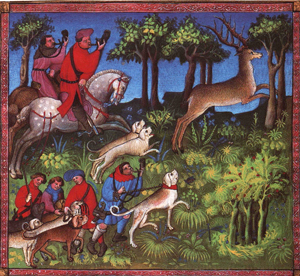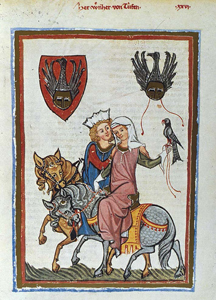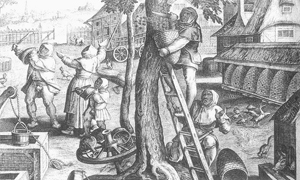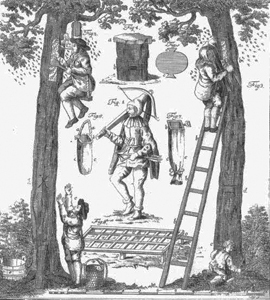Hunt use

Illustration of a hunt in the Middle Ages (14th century)
The hunt is one of the oldest forest uses and at the beginning it only served for aliment supply and vital security. The skins were used to manufacture clothes and the bones for tools and weapons. The meat represented an essential basis of nutrition.
At the beginning of the Middle Ages time, every farmer, member of the Mark companionship (a group of farmers using together the forest and the pastures) was allowed to hunt. Later on, the sovereigns banished the woods and hunting became a privilege of the nobility. As a consequence of the banishing process, the right to shoot an animal was limited and only the sovereigns were enabled to use the forests.

During the High Middle Ages, the hunt with the falcon was very common in Central Europe. For the gentry it was rather a kind of sport than a supply in venison. Falconry was first a social event where even women could participate in.
In the Charta of Freedom, issued by the countess of Luxembourg Ermesinde II (1186–1247) in 1244 a part of the Grünewald had also been banished. In this section nobody had the right to hunt with dogs, nets or sacks but only with falcons or other birds. In case of non respect a fine of 5 Solidi was imposed.
The following regulations were meant to protect the forest but served mostly to guarantee an undisturbed hunting. The unbridled taste for hunting of some sovereigns caused high damage to pastures and fields. The destruction of the sowing and the harvest made the local farmers suffer from hunger. It is no surprise that the hunt, the damage caused by game animals and the services the bond-slaved had to give were the main reasons that let to the peasants’ revolts in the 14th and the 15th century.
Honey collecting
The profession of the “Zeidler” ( a kind of apiarist) has its origins in the early Middle Ages and was meant for business, all by collecting the honey of domesticated or wild bees. He worked for the sovereigns or the clergy. But unlike the normal apiarist, he did not use a self-made beehive. The strong tree species like lime tree, sallow, pine and oak did not only supply with nectar, but served also as a natural hive, once they had been hollowed by the beekeeper.

Peasants collecting honey – copper engraving (16th century)
The regions covered with conifers and mixed light woods were a necessary condition for natural honey collecting. The honey pickers had their own corporations with their own defined regulations and jurisdiction.

Historic representation of honey collecting
Until the 10th century most of the collected honey came from wild forest bee and represented the only supply in sweeteners. It was only when the wax consumption increased considerably, as castles, churches and monasteries and towns needed to get lightened, that domestic apiculture became more important. More wax was produced and the mead production decreased.
The slow downfall of the honey collecting profession swept over Europe from West to East and with the introduction of sugar cane in the 17th century the honey collecting era was definitely gone. However only the rich gentry could afford sugar cane and this situation only changed after that the production of sugar beets had been started
